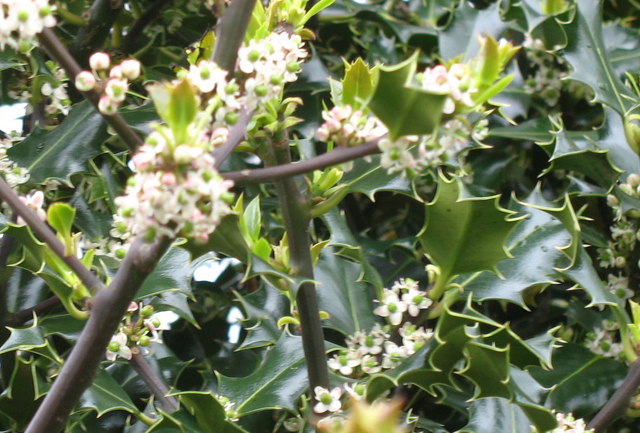Holly

Holly is an easily recognisable evergreen tree with leathery, shiny green leaves that bear sharp, strong prickles along their wavy margins. Interestingly, the lower leaves are much more spiny than leaves further up the tree which have few spikes – why do you think this is?
The trunks of the holly tree are grey and smooth when young but become wrinkled and gnarled as they get older.
Unlike most trees, holly thrives in the shade. The trees can grow up to 15m tall and live for over 300 years.
Holly trees are dioecious – that means that male and female flowers occur on different trees. Female trees produce flowers which have to be pollinated by insects that collect pollen from male trees before they can produce berries. The flowers are small and white that develop in May, the berries develop in July but remain hard and green until the following summer when they will ripen and turn red. The berries are very attractive to birds who eat them but the seed passes through the bird’s gut, these seeds can then grow into new trees if they land in the right places.
Uses:
- wood from holly trees burns well and so is used as firewood. Originally, the Yule log burnt at Christmas was a holly log.
- holly wood is very white, hard and fine grained. It is often used as inlay in carvings, to make furniture or to make walking sticks
- holly used to be grown in upland areas to feed cattle and deer in the winter
- holly is good in hedgerows as it is hardy and is a tough barrier to farm animals all year round
Biodiversity rating:
- blackbirds, redwings, fieldfare and other thrushes love eating holly berries in the winter. In return, they spread the holly seeds far and wide
- many birds nest in holly trees because the spiky leaves provide protection
- many birds roost in holly trees in the winter for the same reason
- dry leaf litter may be used by hedgehogs and small mammals for hibernation
- holly blue butterflies will lay their eggs on holly leaves, mainly in the spring, and the caterpillars will feed on the holly leaves when they hatch out
- the caterpillars of various moths, including the yellow-barred brindle, double-striped pug and the holly tortrix, also feed on holly leaves
- the flowers provide nectar and pollen for bees and other pollinating insects
Mythology and symbolism:
- Holly branches have long been used to decorate homes in winter. Some people think that if the prickliest, lower leaves are brought in first, the husband ruled the household for the year. The smooth, upper leaves gave the wife the upper hand!
- holly was seen as a fertility symbol and a charm against witches, goblins and the devil. It was thought to be unlucky to cut down a holly tree
- Christians link the prickly leaves to Jesus’ crown of thorns
Do you use holly in your Christmas decorations?
Do you know of any songs that mention holly?
